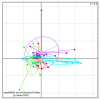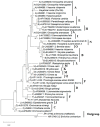Characterization of the Bacterial Microbiome in Natural Populations of Barley Stem Gall Midge, Mayetiola hordei, in Morocco
- PMID: 36985370
- PMCID: PMC10051481
- DOI: 10.3390/microorganisms11030797
Characterization of the Bacterial Microbiome in Natural Populations of Barley Stem Gall Midge, Mayetiola hordei, in Morocco
Abstract
Mayetiola hordei (Kieffer), known as barley stem gall midge, is one of the most destructive barley pests in many areas around the world, inflicting significant qualitative and quantitative damage to crop production. In this study, we investigate the presence of reproductive symbionts, the effect of geographical origin on the bacterial microbiome's structure, and the diversity associated with natural populations of M. hordei located in four barley-producing areas in Morocco. Wolbachia infection was discovered in 9% of the natural populations using a precise 16S rDNA PCR assay. High-throughput sequencing of the V3-V4 region of the bacterial 16S rRNA gene indicated that the native environments of samples had a substantial environmental impact on the microbiota taxonomic assortment. Briefly, 5 phyla, 7 classes, and 42 genera were identified across all the samples. To our knowledge, this is the first report on the bacterial composition of M. hordei natural populations. The presence of Wolbachia infection may assist in the diagnosis of ideal natural populations, providing a new insight into the employment of Wolbachia in the control of barley midge populations, in the context of the sterile insect technique or other biological control methods.
Keywords: 16S rRNA gene; Wolbachia; barley stem gall midge; biological control; next-generation sequencing (NGS); symbiosis.
Conflict of interest statement
The authors certify that this work contains no conflict of interest.
Figures






Similar articles
-
Detection of Wolbachia Infections in Natural and Laboratory Populations of the Moroccan Hessian Fly, Mayetiola destructor (Say).Insects. 2020 Jun 2;11(6):340. doi: 10.3390/insects11060340. Insects. 2020. PMID: 32498270 Free PMC article.
-
Development of new polymorphic microsatellite loci for the barley stem gall midge, Mayetiola hordei (Diptera: Cecidomyiidae) from an enriched library.Int J Mol Sci. 2012 Nov 8;13(11):14446-50. doi: 10.3390/ijms131114446. Int J Mol Sci. 2012. PMID: 23203074 Free PMC article.
-
Conserved and Unique Putative Effectors Expressed in the Salivary Glands of Three Related Gall Midge Species.J Insect Sci. 2018 Sep 1;18(5):15. doi: 10.1093/jisesa/iey094. J Insect Sci. 2018. PMID: 30346621 Free PMC article.
-
Diversity, Tissue Localization, and Infection Pattern of Bacterial Symbionts of the White-Backed Planthopper, Sogatella furcifera (Hemiptera: Delphacidae).Microb Ecol. 2020 Apr;79(3):720-730. doi: 10.1007/s00248-019-01433-4. Epub 2019 Oct 8. Microb Ecol. 2020. PMID: 31595328
-
Harnessing mosquito-Wolbachia symbiosis for vector and disease control.Acta Trop. 2014 Apr;132 Suppl:S150-63. doi: 10.1016/j.actatropica.2013.11.004. Epub 2013 Nov 16. Acta Trop. 2014. PMID: 24252486 Review.
References
-
- Cherif A., Mediouni Ben Jemâa J. Distribution, population dynamics and damage potential of barley stem gall midge, Mayetiola hordei (Diptera: Cecidomyiidae) on cultivated barley in two semi-arid areas of North Tunisia. Crop Prot. 2018;112:295–303. doi: 10.1016/j.cropro.2018.06.017. - DOI
-
- Malipatil M. Industry Biosecurity Plan for the Grains Industry. Threat Specific Contingency Plan Barley Stem Gall Midge. Mayetiola hordei. Plant Health Australia; Canberra, Australia: 2008. p. 23.
-
- Lhaloui S., Bouhssini M.E., Otmane R., Ouriniche S., Alami A. Comparative Biology and Life Cycle of The Barley Stem Gall Midge and Hessian fly (Diptera: Cecidomyiidae) in Morocco. [(accessed on 12 March 2023)];Rev. Maroc. Prot. Plantes. 2016 :17–37. Available online: https://revues.imist.ma/index.php/RMPP/article/view/6420.
-
- Parker B., El-Bouhssini M., Skinner M. Field Guide: Insect Pests of Wheat and Barley in North Africa, West and Central Asia. ICARDA; Beirut, Lebanon: 2001.
-
- Hardie J., Minks A.K. Pheromones of Non-Lepidopteran Insects Associated with Agricultural Plants. CABI Publishing; Wallingford, UK: 1999.
Grants and funding
LinkOut - more resources
Full Text Sources

